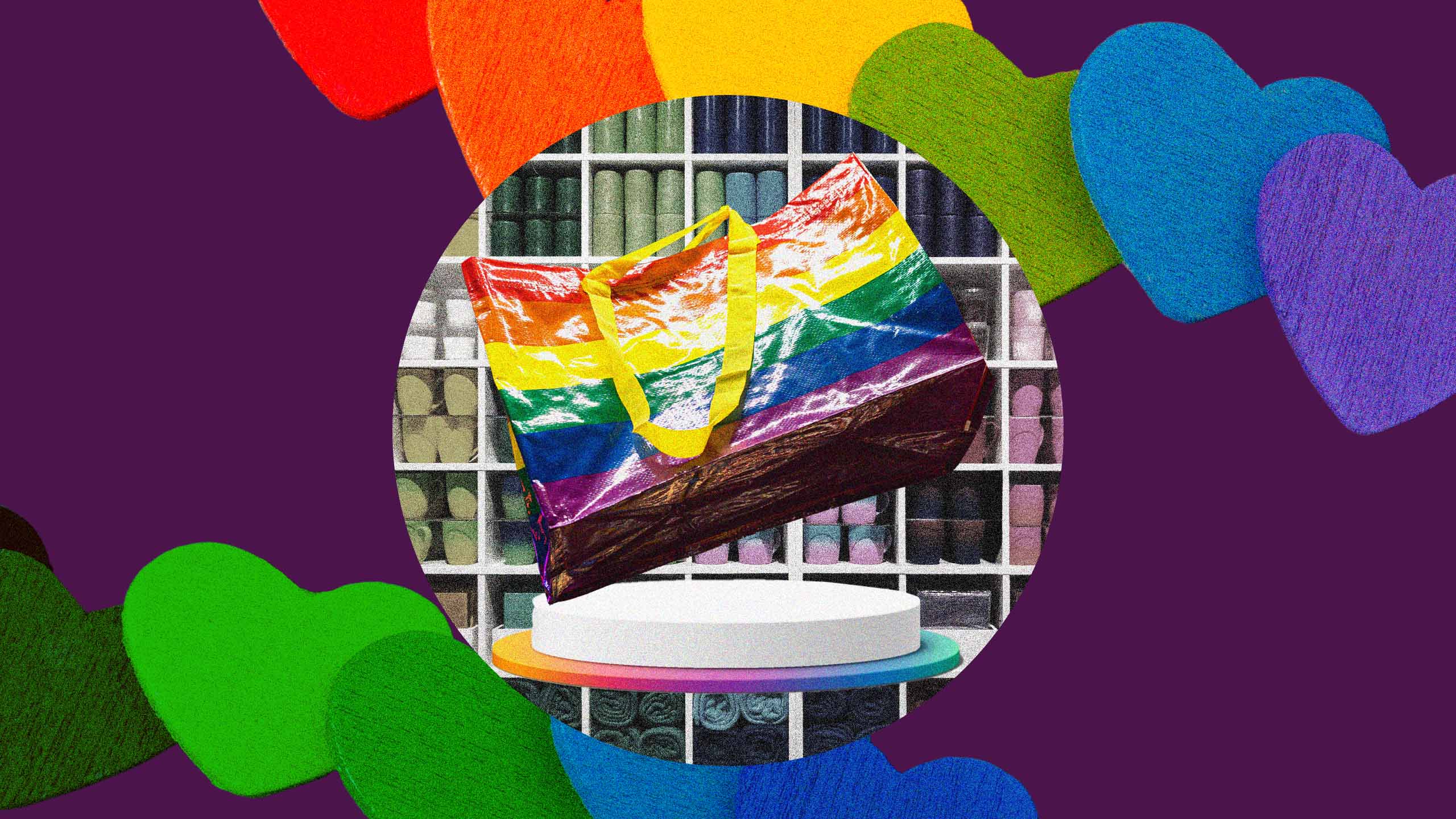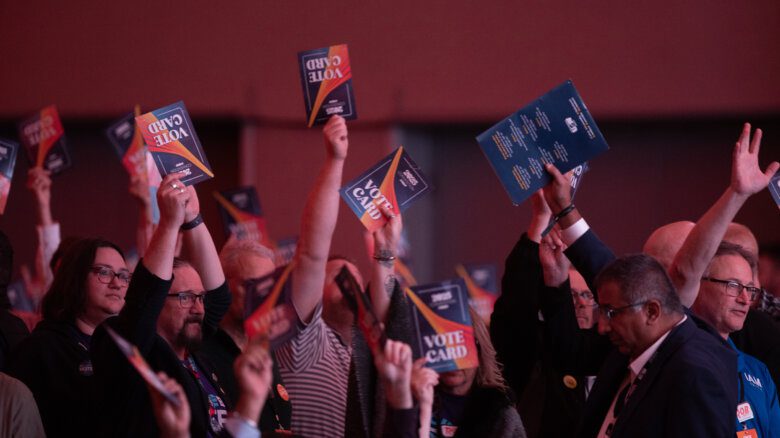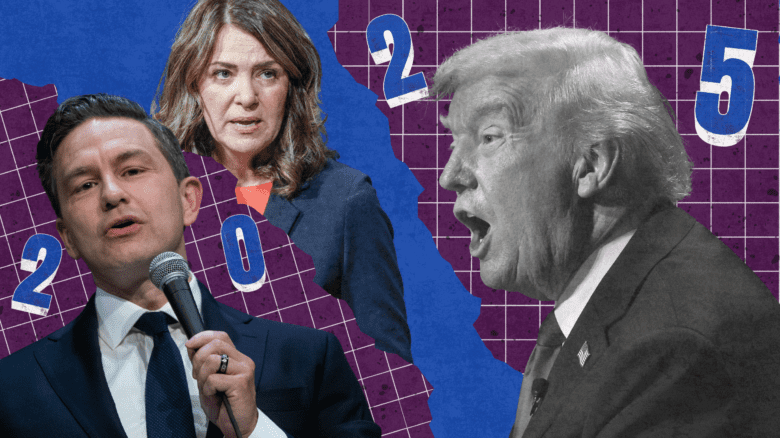Each June it’s rare to visit a shopping centre without getting hit by a barrage of rainbow flag advertisements. But in Australia, where I’ve been travelling, the approach is comparatively muted. Consider the case of Woolworths, the country’s dominant grocery chain. One of its marketers posted on LinkedIn that this June there wasn’t a Pride campaign, per se. Instead, the company featured an in-store ad of two men showing up at someone’s doorstep, one holding a small child in a winter hat, the other cradling a lasagna. It’s implied, though not outright stated, that they are a queer couple. I can’t say I noticed the depiction as I shopped for groceries. Perhaps because there was so much other Pride-related noise that it was hard to pick up on subtle approaches.
Though Ad Age reports that social media mentions of Pride are up this year, they’re becoming increasingly negative and full of anti-LGBTQ2S+ rhetoric. It’s not unexpected that there’s pushback against LGBTQ2S+ issues or Pride—we’re sadly used to that. But the tone and the criticism came with new aggression and fervour that pushed it a step beyond what we’re accustomed to.
Madrid-headquartered communications consultancy LLYC analyzed more than 169 million Pride social media discussions from 12 countries and found, over a multi-year period, supportive messages have declined by about 41 percent. The gap between supporter and detractor messages has also been getting smaller.
That’s not surprising as anti-LGBTQ2S+ sentiments continue to flare in every corner of North American society: from political chambers and schools, to healthcare, libraries and beyond. In the U.S., especially, this furor is translating to changes in law affecting everything from the availability of gender-affirming healthcare to whether businesses have to serve LGBTQ2S+ customers to, in the state of Florida, if educators can discuss sexual orientation and gender identity. There’s a continued anger, if not obsession, from conservative critics over drag queen storytime, which gets reported play-by-play by mainstream media, even in Canada.
Despite this backdrop, corporations and organizations still participated in Pride Month, but the stories dominating headlines and many of our social feeds looked less like a rainbow and more like a storm was brewing.
If Pride marketing this year was an iceberg, the highest point would be the two stories that led coverage as Pride Month kicked off: the fallout from trans influencer Dylan Mulvaney’s promotion for Bud Light and Target’s Pride merchandise collection.
@xtramagazine This week, Target announced that the company will be rolling back some of its Pride Month products after a wave of transphobic backlash. It’s part of a worrying trend from brands giving in hate 🏳️⚧️👙 #fyp #foryoupage #target #pride #pridemonth #rainbowcapitalism #corporatepride #pinkwashing #dylanmulvaney #budlight #trans #lgbtq ♬ original sound – Xtra Magazine
For the uninitiated, conservative critics started pouncing on Mulvaney’s short Instagram sponsored post for a Bud Light contest—lighting up social media and other news sources. Following a wan statement (“We never intended to be part of a discussion that divides people”), Bud Light parent company Anheuser-Busch’s stock price and sales tumbled amid continued boycotts. The company reported this month it lost about USD $395 million in North America during the second quarter of 2023. It’s likely that anger from across the board contributed to this sales decline. While a vocal swath of conservatives were angered that the brand had partnered with a trans woman, there were LGBTQ2S+ consumers also mad because the brand essentially apologized for doing so.
At Target, the nearly 2,000-location discount store chain, critics of the company’s Pride merchandise and its prominent placement in stores, showed up to cause havoc, dismantling displays and confronting employees. This anger was partially stoked by the spreading of misinformation, including the false claim that a line of adult-size, “tuck-friendly” swimsuits was designed for kids. The company ended up moving displays to less prominent locations and removing a product line by a trans designer to quiet critics. Yet this didn’t quash the issue. According to Ad Age, Target was the marketer with the most negative mentions.
While there are many reasons to critique the rainbow intersection of capitalism and Pride, which is a cash grab at its worst, and can feel insincere even when intentions are good, this year calls for a deeper analysis.
In a recent Globe and Mail column, I wrote that we should watch Pride marketing closely and note what’s happening; that there were going to be important takeaways for the community and allies. We need to look below the surface of the Pride iceberg to better understand how to use LGBTQ2S+ purchasing power to support companies that genuinely stand behind us, to protect community members who take part in campaigns and to understand how Pride 2023 differed from past years.
Now that most corporate Pride filters are set aside until next June, I wanted to put this to the test. I reached out to some LGBTQ2S+ marketing experts and industry watchers to separate the messages we need to take away from the noise in this particularly eventful year of Pride promotions. The good news is that not all is lost, but there are some important takeaways that require serious soul-searching both for corporations trying to reach out to us, and consumers spending rainbow dollars.
Strong support despite the noise
Lurking below the surface of Pride month marketing lie some encouraging figures that act as a sort of ballast. For instance, a GLAAD survey found that “70 percent of non-LGBTQ adults agree companies should publicly support the LGBTQ community through hiring practices, advertising and/or sponsorships.” This suggests that the critical voices heard online and in the media are likely simply the loudest, rather than the most representative of public sentiment.
There are also signs that many companies kept up their Pride Month promotions or doubled down this year, including a report from The Guardian suggesting that several major companies kept up or escalated sponsorships despite Pride’s ominous lead-in. Though, Fabrice Houdart executive director of the Association of LGBTQ+ Corporate Directors, tells Xtra that given the timelines of the Bud Light and Target controversies, near the start of Pride Month and continuing to flare throughout, “for most companies it was a bit late to change the marketing approach.”
Cracker Barrel, a Southern restaurant chain, even added a bit of inadvertent levity to Pride after it chimed in. After a conservative Christian values group called the Texas Family Project tweeted that “Cracker Barrel had fallen,” it launched a series of memes on Twitter. And outdoor apparel company The North Face stood against criticism, including from prominent American politicians, with a Pride promotion featuring the drag performer Pattie Gonia.
By June 22, GLAAD announced that 50 companies had signed on to a support statement rejecting bullying and harassment and reaffirming “unwavering commitment to the LGBTQ community.” Signatories include major international, publicly traded firms like American Airlines, HP Inc., Levi Strauss & Co., Nike and Sony Music. Others have since signed on to the pledge, pushing the total near 70.
“There are so many instances of organizations that have a historical commitment to historically marginalized groups, including LGBTQ2S+ populations, that have been doing this work for 20, 30 years,” says E. Ciszek, an associate professor at the University of Texas Stan Richards School of Advertising & Public Relations. They cite American Airlines, MAC Cosmetics, Marriott Hotels and Levi Strauss & Co. as examples. While these groups didn’t make flashy headlines, “their histories tell a different story about how they engage with LGBTQ2S+ customers.”
The end of Pride-washing?
Despite the good news, and the recognition that a few negative stories were driving coverage, I thought something felt different about Pride campaigns this June.
Farhad Divecha of OUT Loud, a U.K.-based LGBTQ+ digital marketing agency, also noticed a shift. He believes that although Pride campaigns were more muted this year, it might be a change in a frequent complaint from the LGBTQ+ community. Divecha notes that “even before the negative events occurred, organizations seemed more aware of Pride-washing and held back.” (By this Divecha refers to the practice of companies using marketing and public relations to overrepresent their level of allyship and outreach to the LGBTQ2S+ allyship.)
“I think the general economic climate and the debate around trans rights had a big role to play in this,” he says. But he also believes that mature brands are starting to understand the negative impact of Pride-washing and are becoming more sensitive with their participation.
“I’d like to think that over time we’ll see this maturing into year-round support, but honestly, I think we’re unfortunately far from that today.”
Boycotts may change marketing behaviour
One of the biggest lessons from Pride was that the boycott of Bud Light was successful, so this potential is something companies will take into account in the future. “I think that for a lot of companies that were on the fence on whether they should have an engagement around Pride, they’re probably not going to engage next year or have a marketing campaign around Pride,” says Houdart.
But he thinks other companies present in the space will go even harder. “If you are in fashion or if you are in cosmetics and know that your customers tend to have views that are sympathetic to non-binary people and sympathetic to the LGBTQ2S+ community, you’re probably going to double down.”
For the boycott threats that emerged besides Bud Light, however, few took hold. For instance, Walmart—which has double the number of American locations as Target—didn’t experience significant pushback or boycotting for its Pride collections. A similar boycott threat over Pride merchandise at Kohl’s stores didn’t advance either.
Harris Poll found that 65 percent of LGBTQ2S+ people they surveyed boycotted brands that “harm or diminish queer people or threaten their rights.” Italian pasta firm Barilla offers an interesting case study of a turnaround. Following anti-gay comments by the company’s CEO and global backlash, the company entered a multi-year commitment to improve its allyship and outreach.
Graham Nolan, public relations consultant and co-chair of LGBTQ2S+ advertising non-profit Do the WeRQ, thinks that brands like Anheuser-Busch and Target, companies with decades of prior experience and outreach with the LGBTQ2S+ community, “could roar back with renewed commitment” for Pride in the future. He notes in the case of Target it was “not their first Pride collection, this was their new Pride collection.”
The purchasing power of rainbow dollars
The asset management and corporate advisory firm LGBT Capital calculates the global purchasing power of queer and trans consumers at an estimated USD $3.9 trillion at the end of 2019. (In Canada, it sits at about USD $90 billion.) There has been renewed conversation over this power in recent months following a February Gallup poll, which reported that nearly 21 percent of Gen Z Americans identify as LGBTQ2S+, a figure far outpacing older generations. This is important when considering Pride fallout as it suggests a growing consumer community that companies can’t ignore. Furthermore, surveys show these customers want to support companies that live their values.
Therefore, Houdart says, a lot of companies look at Pride advertising—especially those who target younger consumers—as a “no-brainer.” “Those people that are screaming at you are not your customers, they are not your future customers. And so it doesn’t really matter.”
Yet Nolan says that what happens instead is they get rewarded.
In the case of Target, for instance, after anti-LGBTQ2S+ people pursued violent acts against the company, part of its response was to limit inventory designed for the LGBTQ2S+ community. “The people being punished, the people being made more invisible, are not the people who are committing acts of violence.”
Need to address safety going forward
“I think organizations need to think about the safety of the influencers they work with and the safety of their employees and the safety of their various partners and stakeholders when thinking through initiatives like Pride campaigns in the future,” says Ciszek.
They tell Xtra that “the way in which violence has been threatened against LGBTQ2S+ people this year feels a little different than the ways oppositional critics have been responding to Pride in the past.” Ciszek, who worked in the advertising industry prior to academia, points out the video of Kid Rock shooting Bud Light cans or bomb threats received by Target stores.
In a statement announcing changes to its Pride product line and displays, Target said it “had experienced threats impacting our team members’ sense of safety and well-being while at work.” (Retail work, according to the U.S. Centers for Disease Control and Prevention, is already an occupation where employees are at high risk for workplace violence.)
Mulvaney, the influencer at the centre of the Bud Light storm, left the U.S. temporarily over safety concerns, and in a video posted online at the end of June said that Anheuser-Busch never reached out to her following the controversy. She went on to say that hiring a trans person only to abandon them in such a circumstance “is worse in [her] opinion than not hiring a trans person at all.
“Because it gives customers permission to be as transphobic and hateful as they want,” she added. “And the hate doesn’t end with me; it has serious and grave consequences for the rest of our community.”
Organizations can prioritize the safety of people they work with by making sure to support them publicly in case of backlash and to have a crisis-management plan ahead of time so they aren’t scrambling to design a response in real-time. This treatment is important to consider when spending money, as LGBTQ2S+ people who want to spend in ways that reflect their values, may well want to include how companies look out for people and groups they use in campaigns as a metric.
The end of amateur hour
Nolan, says one of the most important marketing lessons from this past Pride is best summed up in a quote from Houdart’s newsletter: “I am being asked frequently if the politicization of workplace inclusion and the ‘anti-woke’ movement are ringing the bell of the end of corporate advocacy on social issues,” Houdart writes. “It instead is the end of amateurism in Corporate Social Responsibility engagement.”
Though companies and individuals recoil from backlash with surprise, Nolan doesn’t understand it.
“I saw this headline that said ‘Target faces Pride backlash.’ And I was like, that only surprises you if you’re unaware of the headline that’s at the forefront of our community’s anxieties, which is that LGBTQ2S+ faces existence backlash.”
Nolan says companies can’t act surprised anymore—when they participate in Pride, their actions are inherently political, whether or not they like that. When dealing with backlash, companies need to be prepared instead of acting like they didn’t know what to do.
Between this and the other critical questions this Pride season has advanced, one thing is for sure. This year is unlikely to be remembered as a good or a bad year for Pride, but more of a transformational one. The echoes of what we’ve witnessed will shape the behaviour of LGBTQ2S+ consumers and the companies that promote to them for years to come.


 Why you can trust Xtra
Why you can trust Xtra


